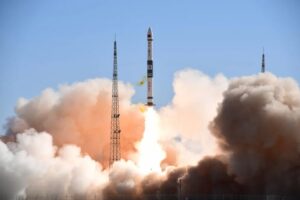Digging into our new drill hole: Sols 3517-3518
Wednesday, 29 June 2022 02:49 After a successful drilling of Avanavero, the team is ready to dig even deeper into our investigation of this new drill target. Tosol's plan includes an important part of this process: our initial analysis of the drilled sample with the CheMin instrument.
In addition, the team planned three full hours of remote science activities at this new drill site, including a ChemCam LIBS observation
After a successful drilling of Avanavero, the team is ready to dig even deeper into our investigation of this new drill target. Tosol's plan includes an important part of this process: our initial analysis of the drilled sample with the CheMin instrument.
In addition, the team planned three full hours of remote science activities at this new drill site, including a ChemCam LIBS observation Exotic carbon microcrystals in meteorite dust
Wednesday, 29 June 2022 02:49 The largest meteorite observed so far this century entered the Earth's atmosphere above Chelyabinsk in the Southern Urals, Russia on February 15, 2013. Unusually, dust from the surface of this meteorite survived its fall and is being extensively studied.
This dust includes some unusually shaped microcrystals of carbon. A study of the morphology and simulations of the formation of these cry
The largest meteorite observed so far this century entered the Earth's atmosphere above Chelyabinsk in the Southern Urals, Russia on February 15, 2013. Unusually, dust from the surface of this meteorite survived its fall and is being extensively studied.
This dust includes some unusually shaped microcrystals of carbon. A study of the morphology and simulations of the formation of these cry Unraveling a meteorite mystery reveals solar system origin story
Wednesday, 29 June 2022 02:49 The violent event that likely preceded our Solar System's formation holds the solution to a longstanding meteorite mystery, says new work from Carnegie's Alan Boss published in The Astrophysical Journal.
The raw material from which our Solar System was constructed was dispersed when the shock wave from an exploding supernova injected material into a cloud of dust and gas, causing it to col
The violent event that likely preceded our Solar System's formation holds the solution to a longstanding meteorite mystery, says new work from Carnegie's Alan Boss published in The Astrophysical Journal.
The raw material from which our Solar System was constructed was dispersed when the shock wave from an exploding supernova injected material into a cloud of dust and gas, causing it to col Help NASA scientists find clouds on Mars
Wednesday, 29 June 2022 02:49 NASA scientists hope to solve a fundamental mystery about Mars' atmosphere, and you can help. They've organized a project called Cloudspotting on Mars that invites the public to identify Martian clouds using the citizen science platform Zooniverse. The information may help researchers figure out why the planet's atmosphere is just 1% as dense as Earth's even though ample evidence suggests the pl
NASA scientists hope to solve a fundamental mystery about Mars' atmosphere, and you can help. They've organized a project called Cloudspotting on Mars that invites the public to identify Martian clouds using the citizen science platform Zooniverse. The information may help researchers figure out why the planet's atmosphere is just 1% as dense as Earth's even though ample evidence suggests the pl Long-term liquid water also on non-Earth-like planets
Wednesday, 29 June 2022 02:49 Liquid water is an important prerequisite for life to develop on a planet. As researchers from the University of Bern, the University of Zurich and the National Centre of Competence in Research (NCCR) PlanetS report in a new study, liquid water could also exist for billions of years on planets that are very different from Earth. This calls our currently Earth-centred idea of potentially habitabl
Liquid water is an important prerequisite for life to develop on a planet. As researchers from the University of Bern, the University of Zurich and the National Centre of Competence in Research (NCCR) PlanetS report in a new study, liquid water could also exist for billions of years on planets that are very different from Earth. This calls our currently Earth-centred idea of potentially habitabl NASA to launch two more sounding rockets from northern Australia in July
Wednesday, 29 June 2022 02:49 On the heels of a successful launch on June 26, NASA is set to launch two more sounding rockets from northern Australia during the first half of July. These missions will help astronomers understand how starlight influences a planet's atmosphere, possibly making or breaking its ability to support life as we know it.
The two missions will look at Alpha Centauri A and B - two Sun-like stars
On the heels of a successful launch on June 26, NASA is set to launch two more sounding rockets from northern Australia during the first half of July. These missions will help astronomers understand how starlight influences a planet's atmosphere, possibly making or breaking its ability to support life as we know it.
The two missions will look at Alpha Centauri A and B - two Sun-like stars GMV cements leadership in collision avoidance operations automation and coordination in Europe
Wednesday, 29 June 2022 02:49 Space is getting congested and today, active collision avoidance has become a routine task in space operations, relying on validated, accurate and timely space surveillance data. For a typical satellite in LEO, hundreds of conjunction alerts can be expected every week. Processing and filtering these still leaves about two actionable alerts per spacecraft and week requiring detailed follow-up by
Space is getting congested and today, active collision avoidance has become a routine task in space operations, relying on validated, accurate and timely space surveillance data. For a typical satellite in LEO, hundreds of conjunction alerts can be expected every week. Processing and filtering these still leaves about two actionable alerts per spacecraft and week requiring detailed follow-up by ICEYE expands its business to offer complete satellite missions for customers
Wednesday, 29 June 2022 02:49 ICEYE, an Earth observation company operating the world's largest synthetic-aperture radar (SAR) satellite constellation, has announced the establishment of a new line of business focused solely on delivering fully operational satellite missions to customers looking for their own orbital SAR capabilities.
Governments and large multinational corporations are able to purchase their own radar
ICEYE, an Earth observation company operating the world's largest synthetic-aperture radar (SAR) satellite constellation, has announced the establishment of a new line of business focused solely on delivering fully operational satellite missions to customers looking for their own orbital SAR capabilities.
Governments and large multinational corporations are able to purchase their own radar Terran Orbital Developed CAPSTONE Heads to the Moon
Wednesday, 29 June 2022 02:49 Terran Orbital Corporation (NYSE: LLAP), a global leader in satellite solutions, primarily serving the United States and Allied aerospace and defense industries, has announced the successful launch of the CAPSTONE satellite. The Terran Orbital designed and built Cislunar Autonomous Positioning System Technology Operations and Navigation Experiment, otherwise known as CAPSTONE, launched this morn
Terran Orbital Corporation (NYSE: LLAP), a global leader in satellite solutions, primarily serving the United States and Allied aerospace and defense industries, has announced the successful launch of the CAPSTONE satellite. The Terran Orbital designed and built Cislunar Autonomous Positioning System Technology Operations and Navigation Experiment, otherwise known as CAPSTONE, launched this morn MDA provides Global Fishing Watch access to Radarsat-2 archive to help combat illegal fishing
Wednesday, 29 June 2022 02:49 MDA Ltd. (TSX:MDA), a leading provider of advanced technology and services to the rapidly expanding global space industry, announced at the 2022 UN Ocean Conference a major new contribution to international efforts to monitor, track and intercept illegal, unreported and unregulated (IUU) fishing activities using satellite technology.
MDA is providing Global Fishing Watch (GFW) - an interna
MDA Ltd. (TSX:MDA), a leading provider of advanced technology and services to the rapidly expanding global space industry, announced at the 2022 UN Ocean Conference a major new contribution to international efforts to monitor, track and intercept illegal, unreported and unregulated (IUU) fishing activities using satellite technology.
MDA is providing Global Fishing Watch (GFW) - an interna Rocket Lab sees payoff from CAPSTONE launch
Wednesday, 29 June 2022 01:48
The successful launch of a NASA lunar cubesat mission was the culmination of two and a half years of work at Rocket Lab that, the company’s chief executive says, could enable “ridiculously low cost” planetary missions.
Space Force acquisition chief to meet with ULA and Blue Origin, expects Vulcan to launch in December
Tuesday, 28 June 2022 22:21
Frank Calvelli said he wants to make sure Blue Origin and ULA understand 'the importance of hitting their milestones' for the BE-4 and Vulcan
The post Space Force acquisition chief to meet with ULA and Blue Origin, expects Vulcan to launch in December appeared first on SpaceNews.
Virgin Orbit ready for first night launch
Tuesday, 28 June 2022 22:02
Virgin Orbit says it’s ready for a nighttime launch for the U.S. Space Force as it attempts to get into a more frequent rhythm of building and launching vehicles.
The post Virgin Orbit ready for first night launch appeared first on SpaceNews.
Ovzon needs to piggyback another Ariane 5 ride for late 2022 launch
Tuesday, 28 June 2022 17:15
Arianespace is looking to move Ovzon’s first satellite to another Ariane 5 after Eutelsat switched to a dedicated mission to launch sooner.
The post Ovzon needs to piggyback another Ariane 5 ride for late 2022 launch appeared first on SpaceNews.
Chinese commercial launch firm Expace raises $237 million
Tuesday, 28 June 2022 14:38
Chinese launch service provider Expace has secured $237 million in B round funding, following last week's return to flight of its Kuaizhou-1A solid rocket.

